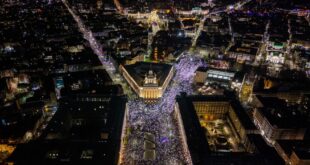Former Serbian state security officials Jovica Stanisic and Franko Simatovic will hear the judgment in The Hague this week in their retrial for masterminding the most notorious Serb combat units that fought in the Croatian and Bosnian wars.
“Milosevic’s men on the ground” was the most common description of these two leading Serbian state security officials – Jovica Stanisic, chief of the interior ministry’s State Security Service and his right-hand man, Franko ‘Frenki’ Simatovic, commander of the service’s Special Operations Unit.
On June 30, the UN’s International Residual Mechanism for Criminal Tribunals, which is dealing with the final cases from the Yugoslav war crimes tribunal in The Hague, will hand down its verdict after the two men’s retrial.
The indictment alleges that they were part of a joint criminal enterprise together with Yugoslav President Slobodan Milosevic, Serbian Radical Party leader Vojislav Seselj, Croatian Serb leader Goran Hadzic, Croatian Serb commander Milan Martic, Bosnian Serb leader Radovan Karadzic, Bosnian Serb military chief Ratko Mladic and Bosnian Serb ex-president Biljana Plavsic.
Their aim, the indictment says, was the forcible and permanent removal of the majority of non-Serbs from large areas of Croatia and Bosnia.
The prosecution believes that they controlled and used various units for this purpose from 1991 onwards – the Knindze (‘Ninjas’ from the town of Knin), the Scorpions, Arkan’s Tigers (officially known as the Serbian Volunteer Guard), the Red Berets and the Special Operations Unit.
The leader of the Knindze, Dragan Vasiljkovic, known as Captain Dragan, was convicted by a Croatian court in 2017, but none of the other units’ battlefield commanders have never faced trial for war crimes.
However, the Red Berets’ last commander, Milorad Ulemek, known as Legija, was sentenced to 40 years in jail for his role in the assassination of late Serbian Prime Minister Zoran Djindjic in 2003, while two other former commanders, Zeljko ‘Arkan’ Raznatovic, and Radovan ‘Badza’ Stojicic, were killed in mafia shootings in Belgrade after the war.
According to the prosecution, the people who organised, supplied, financed, supported and directed the training of these units were Stanisic and Simatovic.
Outsourcing the worst violence
The idea to form a special unit that would protect Serbs outside the country, in areas of the former Yugoslavia which were already on the brink of war, originated in March 1991 from Milosevic himself.
Speaking at a gathering of local Serb leaders, Milosevic said: “The government has an assignment to prepare additional groups which will make us safe and enable us to defend the interests of our republic, but also the interests of Serbs outside Serbia.”
Iva Vukusic, a historian in Conflict Studies at Utrecht University in the Netherlands, said that there were three main reasons for the creation of the paramilitary units; the first being to fill troop shortages because “there weren’t that many people who wanted to fight in the war”.
The second reason was to provide “plausible deniability”, Vukusic said. They could be used to fulfil the state’s goals, but at the same time, “the state could say ‘we have nothing to do with these units, these units are not part of our military, they’re not a formal part of our armed forces, thereby we are not responsible for them’”.
“This is an easy way for states to outsource some of the worst violence, so to say, to actors that they are formally, not associated with it,” she explained.
The third reason, according to Vukusic, was because “paramilitaries like these are often open to people with criminal backgrounds, people that come from sort of violent environments and people that are not so concerned about following the law”.
A month after Milosevic’s speech, Jovica Stanisic, who at the time was chief of state security went to the Croatian town of Knin with Dragan Vasiljkovic to help local rebels Serbs form a secret military unit, the Knindze, to help them maintain their self-proclaimed Republic of Srpska Krajina.
Frenki, the ‘arrogant boss’
The man who took care of operational work on the ground was ‘Frenki’ Simatovic, who did intelligence work in Croatia and Bosnia.
According to the indictment, Simatovic “functioned under the authority of Jovica Stanisic”, while many witnesses at the trial described him as Stanisic’s “eyes, ears and right hand”.
Adam Weber, one of prosecutors in the case in The Hague from 2009 to 2013, said that Stanisic and Simatovic were “the sparks that lit the house on fire”.
“If you look at their roles during the course of the conflict, they had a very essential and critical part in causing and then continuing the ethnic cleansing campaign, I mean through their arming, through their financial support, through their deployment of the special units, they really fuel the ethnic tensions that envelops the rest of Croatia and then Bosnia and Herzegovina,” Weber explained.
Despite the fact that Simatovic denied that Serbian state security ever coordinated or controlled special units on the ground, a speech he made in 1997 became crucial evidence for the prosecution as it appeared to prove that a covert unit had been established by the Serbian authorities years earlier, at the start of the Yugoslav wars.
“The unit was formed in May 1991, when Yugoslavia was falling apart and from its foundation the unit functioned as a tool for maintaining the national security of the Serb people… in all their ethnic areas,” Simatovic said.
A number of other witnesses at the two men’s trial confirmed that they were on Serbian State Security’s payroll.
“Salaries in the Berets and Tigers were paid in cash, in special envelopes, while in the Berets people received twice as much as the Tigers,” Dejan Sliskovic, a former unit member, told the court in 2010.
Other ex-members claimed that “everyone knew that Frenki controlled the units”. Some described him as “bossy and arrogant”.
The trial also heard that the various commanders, such as Arkan or Legija, were “regularly coming for consultation at the headquarters of Stanisic and Frenki”.
Vukusic said it was well-known that Simatovic operated in the field.
“People actually just talked about him as ‘Frenki’, he was so well-known that there are documents that he only signs as Frenki. That means that people know you,” she said.
As the conflict started to spread to other areas of the former Yugoslavia in the early 1990s, the Serbian leadership decided to deploy another man besides Frenki, and appointed Radovan ‘Badza’ Stojicic as the head of Territorial Defence forces.
The prosecution listed Stojicic as a part of the joint criminal enterprise together with Milosevic, Simatovic and Stanisic, but never indicted him. For the most brutal operations in parts of Croatia and eastern Bosnia, Stojicic engaged Arkan and his Serbian Volunteer Guard unit, popularly known as the Tigers.
According to the indictment of Simatovic and Stanisic, Arkan’s men were responsible for killing at least 40 detainees near the Dalj mountain in Croatia and 26 Croat civilians who were dumped in the River Danube, while in Bosnia, the Tigers allegedly killed at least 80 people in the town of Sanski Most and 20 non-Serb civilians in the town of Zvornik.
Arkan, who was indicted for war crimes in 1996, never faced trial because he was shot dead in Belgrade in 2000.
The fall of Stanisic
In 1998, two years after the Special Operations Unit was officially established, Stanisic was removed from his position as State Security chief. Following the end of the war in Bosnia, protests against Milosevic had erupted in Belgrade, and Stanisic met opposition leaders on several occasions, raising suspicions about his loyalty.
Milosevic also suspected that Stanisic had connections with foreign secret services, including the CIA, because he advocated that the international community become involved in the conflict in Kosovo.
As a result, Stanisic was fired. However, veteran Serbian journalist Milos Vasic claims that Stanisic actually resigned because “it was clear to him from the beginning that the whole thing would not end well”.
Stanisic took retirement in July 2000, followed by Simatovic in December 2001.
The Special Operations Unit existed until 2003, when it was disbanded because many of its members, including Legija, were directly involved in the assassination of Serbian Prime Minister Djindjic.
In the same year, the Hague prosecution filed an indictment charging Stanisic and Simatovic with murder, persecution on political, racial and religious grounds, deportation and inhumane acts.
They were arrested soon afterwards, and their trial started in 2008. Both men pleaded not guilty and were acquitted in 2013, but the verdict was overturned in 2015. They pleaded not guilty again when the retrial began.
Stanisic has not attended hearings since 2017, when he was given provisional release because he is suffering from a chronic digestive disease and depression, although he is expected to be in court for the verdict.
 Eurasia Press & News
Eurasia Press & News

